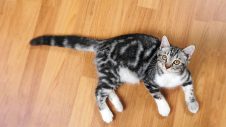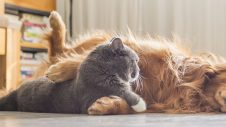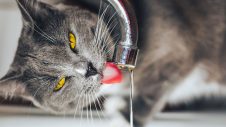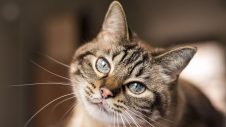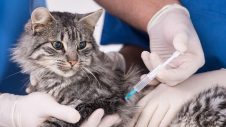What is feline hyperthyroidism?
Feline hyperthyroidism is the most common hormonal disorder in cats. It’s most common in older cats. Though it has been recorded in cats as young as 4 years of age, it is uncommon in cats under 8 years of age. It is a syndrome caused by the increased secretion of thyroid hormone. This is usually due to a benign tumour of the gland. In 2% of cases, it may be a malignant tumour that can spread to other organs.
Clinical signs of feline hyperthyroidism
It is a multi-systemic disease. This means that it affects many body organs and organ systems. Hyperthyroidism can induce similar symptoms to other conditions (e.g. renal failure).
The most common clinical signs are weight loss and increased appetite. Other signs include:
- Hyperexcitability or anxiety.
- Palpable goitre (gland can be felt in the neck).
- Gastrointestinal signs (vomiting or diarrhoea).
- Rapid heart rate/thumping heart.
- Signs of congestive heart failure.
- Fluid retention in the chest and abdomen (relates to heart symptoms).
- Increased drinking and urination.
- Some cats have alternating periods of decreased and increased appetite.
Diagnosis of feline hyperthyroidism
Diagnosis is via a blood test. The level of thyroid hormone is measured in the serum. A general blood test for the liver and kidney function can also be useful.
Treating feline hyperthyroidism
There are three treatment options:
1. Radioactive iodine treatment
This is only available through specialist centres. The cat is given a capsule containing radioactive iodine, which is taken up into the gland and kills the gland tissue. It is a very safe and effective treatment, but it involves a hospital stay in a special lead-lined room until the level of radioactivity in the cat is deemed safe – usually 7-10 days.
2. Surgical
Despite most cats with hyperthyroidism being quite old, surgery usually produces dramatic results. There is no need for an extended stay in the hospital, and the cost for this treatment is usually less than for radioactive iodine treatment. However, this is only useful for cats with an enlarged thyroid gland.
3. Medical
Medical treatment may be adequate in the short term or as a preparation for surgery, but it is not as successful in long-term management. Some patients with other health problems, such as diabetes or kidney failure, may be best treated this way.
The outlook for most cats with thyroid disease is very good, so prompt identification and treatment of the problem will rapidly improve your cat’s quality of life.

 Greencross Vets
Greencross Vets 